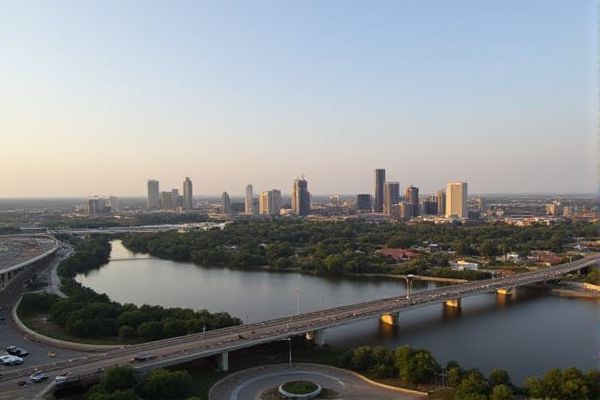
Transportation and commuting in Oklahoma: Extensive highway systems simplify statewide travel. Public transit limited to larger cities like Oklahoma City, Tulsa. Cost-effective gas prices for long commutes. Car ownership is almost essential in rural areas. Rideshare services available in urban areas. Amtrak connects Oklahoma City to Fort Worth. Bike-friendly trails in major cities. Limited commuter rail services. Airports easily accessible across the state. Traffic congestion minimal compared to national average.
Extensive highway systems simplify statewide travel.
Oklahoma's extensive highway system, comprising 30,000 lane miles including 673 miles of non-tolled interstate, simplifies statewide travel by connecting major cities and facilitating the movement of people, goods, and services across the state, making it a crucial link in the nation's network of trade and commerce. To learn more about the current Highway System Conditions and updates within Oklahoma, you can visit the relevant sections on their official website. This network not only supports local economies but also plays a significant role in national and regional transportation logistics.
Public transit limited to larger cities like Oklahoma City, Tulsa.
Public transit in Oklahoma is primarily limited to larger cities like Oklahoma City and Tulsa, with initiatives such as Oklahoma City's new Rapid Bus Rapid Transit system and Tulsa's Aero route on Peoria Ave., which enhance frequency, amenities, and connectivity within these metropolitan areas.
Cost-effective gas prices for long commutes.
As of December 2024, Oklahoma boasts some of the most cost-effective gas prices in the United States, with an average price of $2.53 per gallon. This is 16.3% lower than the national average, making the state particularly favorable for those with long commutes. For further detailed statistics and analysis on how these prices compare across the nation, visit the Cost of Driving by State page on Choose Energy. This resource provides valuable insights into the economics of fueling across different regions.
Car ownership is almost essential in rural areas.
In rural Oklahoma, car ownership is almost essential due to the lack of public transportation, with many residents relying on personal vehicles to access mental health services, healthcare, and other essential services. Areas with low vehicle ownership rates often have the poorest access to transportation, and consequently, the highest rates of poverty and mental health issues. More details about this situation can be found on the KGOU Website, which explores how the availability of reliable transportation directly impacts mental health services accessibility in these communities.
Rideshare services available in urban areas.
In urban areas of Oklahoma, such as Oklahoma City and Tulsa, various rideshare services are available, including Uber, Lyft, Blacklane, and Carmel. These services offer different levels of service, from standard taxis to luxury vehicles, and some also provide airport pickups and specialized transportation options. For more detailed information about these services in Oklahoma City, visit the Ride Guru website.
Amtrak connects Oklahoma City to Fort Worth.
Amtrak's Heartland Flyer connects Oklahoma City and Fort Worth, offering daily train service with stops in several Oklahoma and Texas cities, and providing connections to other Amtrak routes like the Texas Eagle. The journey takes approximately four hours, and the train features coach seating, cafe service, and limited bike racks.
Bike-friendly trails in major cities.
Oklahoma's major cities, such as Tulsa and Oklahoma City, offer several bike-friendly trails. Among these, the Tulsa River Parks Trails, Will Rogers Trail, Osage Prairie Trail, and the Katy Trail stand out for their scenic routes, convenient amenities, and connections to various urban and suburban areas, making them ideal for cyclists looking to explore the beautiful landscapes and vibrant communities within the state.
Limited commuter rail services.
Oklahoma is considering an ambitious plan to develop a new commuter rail system designed to connect key cities such as Oklahoma City, Edmond, and Norman. This initiative aims to enhance walkability and accessibility across the region, with strategically placed multiple stations. The current infrastructure offers limited commuter rail services, relying heavily on the Heartland Flyer, operated by Amtrak, which provides passenger rail service between Oklahoma City and Fort Worth. As the state looks forward to expanding its transportation network, funding for this project remains contingent on voter approval expected in early 2025. You can learn more about the potential impact of such developments on the downtown area by exploring this link to learn more about how commuter rail could fit in with the new Downtown Oklahoma City Arena.
Airports easily accessible across the state.
Oklahoma has several airports, with the primary commercial airports being Will Rogers World Airport in Oklahoma City and Tulsa International Airport, which handle the majority of the state's air traffic. Additionally, there are smaller airports like Lawton-Fort Sill Regional Airport and Stillwater Regional Airport that offer scheduled daily flights, primarily through American Eagle.
Traffic congestion minimal compared to national average.
Oklahoma is the 16th least congested state in the nation, with only two border states, Arkansas and Kansas, being slightly less congested. Despite some congestion in urban areas like Oklahoma City and Tulsa, the state's overall traffic congestion is relatively mild compared to other major cities in the U.S. To learn more about how Oklahoma's roads compare to other states, you can visit the Oklahoma's Road Performance Data provided by the 1889 Institute, which offers comprehensive insights into road and traffic conditions across the state.
